December 19, 2022 feature
A diamond-based quantum amplifier
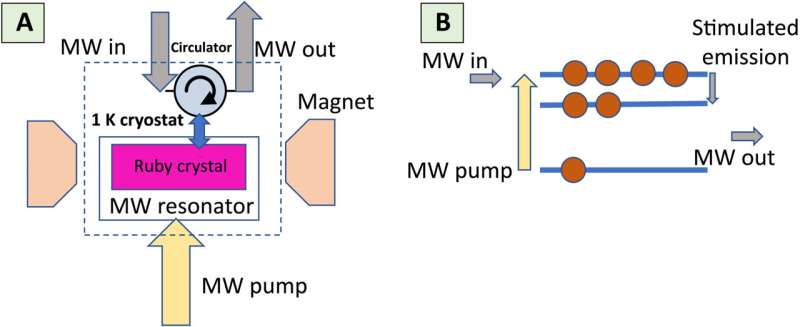
In physics, weak microwave signals can be amplified with minimal added noise. For instance, artificial quantum systems based on superconducting circuits can amplify and detect single microwave patterns, although at millikelvin temperatures. Researchers can use natural quantum systems for low-noise microwave amplification via stimulated emission effects; however, they generate a higher noise at functionalities greater than 1 Kelvin.
In this new work, published in the journal Science Advances, Alexander Sherman and a team of scientists in chemistry at the Technical-Israel Institute of Technology, Haifa, used electron spins in diamond as a quantum microwave amplifier to function with quantum-limited internal noise above liquid nitrogen temperatures. The team reported details of the amplifier's design, gain, bandwidth, saturation power and noise to facilitate hitherto unavailable applications in quantum science, engineering and physics.
Maser technology
Deep space communications, radio astronomy and quantum technology depend on advances that facilitate the amplification and detection of microwave signals with minimal noise. These applications require a very weak signal of relevance at the level of tens of hundreds of microwave photons per second. Any noise added to the signal during the process of amplification can overwhelm the potential of signal detection.
To overcome this, scientists presently use three different types of amplifiers to enhance and detect micro-signals, while adding very low levels of noise. Examples include conventional electronic amplifiers, amplifiers based on superconducting circuits and kinetic conductance parametric amplifiers. For instance, solid-state masers function efficiently at low temperatures with a few photons of noise added to the signal.
In this work, Sherman and colleagues took maser technology a step forward to show its actual functionality as a complete reinvention of an earlier described work by the same group. The outcomes can lead to the realization of a practical device whose properties of amplification and noise can be measured for potential applications in quantum science.
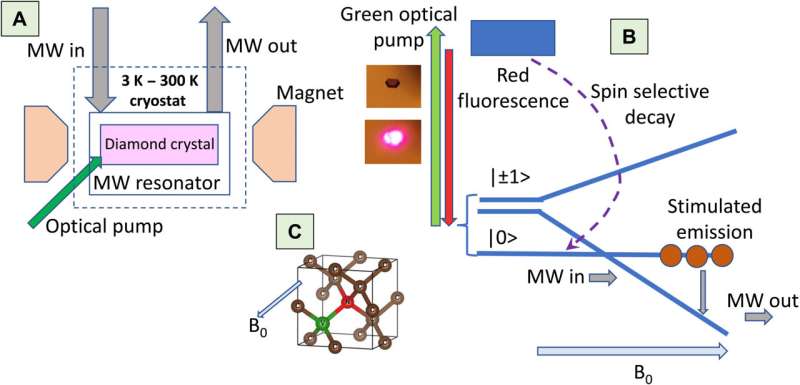
A new maser device
While the maser technology that was in use until very recently relied on technologies developed in the 1950s and 1960s, it is now replaced with conventional electronic amplifiers for ease of functionality. Quantum technology can amplify very weak microwave signals with quantum noise-limited performance for applications across quantum bit readouts and for dark matter detection. However, their continued function and scope depend on ultralow cryogenic temperatures. As a result, researchers use modern maser technology as a solution.
The team designed the new maser to achieve a microwave amplifier with specific dimensions to show quantum noise-limited performance at temperatures higher than 1K. During the experiments, they considered two possible modes of the maser device as an oscillator and amplifier. During oscillatory function, they reduced the coupling of the apparatus in the two microwave parts. To understand its function as an amplifier, they took the coupling properties of its input and output into account.
-
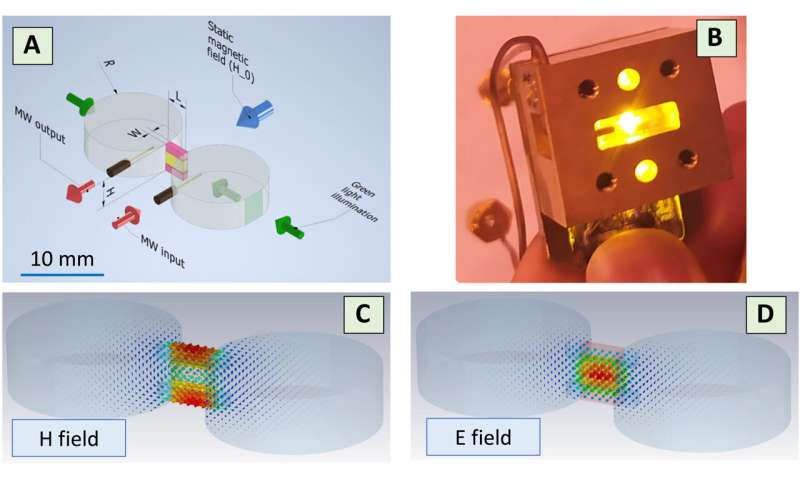
The diamond-based maser amplifier. (A) Schematic overview of the custom-made maser cavity, which has two ports for the MW (in/out) and two optical windows for light irradiation. The two diamond crystals used for the amplification process are positioned at the center (purple), with an Al2O3 single crystal slab positioned between them (yellow). (B) Photograph of the central part of the maser cavity (with the outer portions removed) open on one side, with light irradiation from the opposite side emerging through the diamonds and the Al2O3 crystal. (C) Calculated MW magnetic field of the cavity’s resonant mode with the diamonds and Al2O3 in it. The MW magnetic field is predominantly focused inside the diamond crystals. (D) Same as (C) but for the MW electric field, which is mainly focused inside the Al2O3 crystal. Credit: Science Advances (2022). DOI: 10.1126/sciadv.ade6527 -
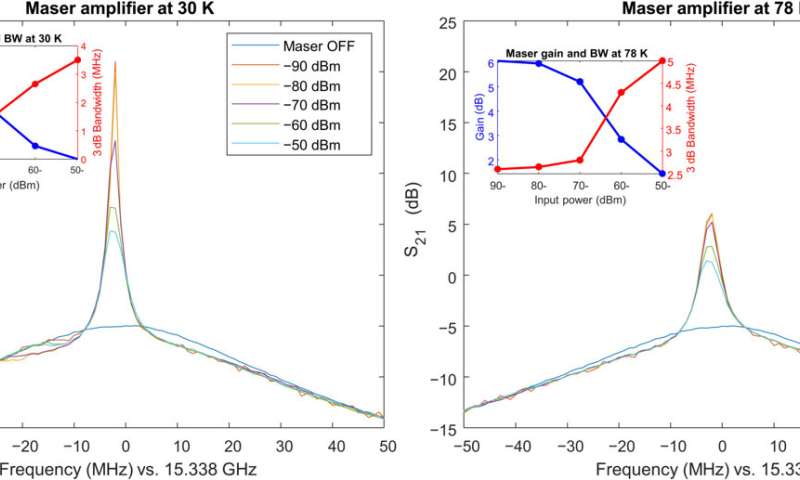
The maser as an amplifier. The maser amplifier’s gain at 30 K (left) and 78 K (right) for various input power levels. When the maser is OFF, there is a ~5-dB loss for signals going through the device due to the coupling properties of its ports (the main loss is due to the undercoupled output port). The insets show the maser’s power gain and 3-dB bandwidth (BW) at these two temperatures. The maser as an amplifier. The maser amplifier’s gain at 30 K (left) and 78 K (right) for various input power levels. When the maser is OFF, there is a ~5-dB loss for signals going through the device due to the coupling properties of its ports (the main loss is due to the undercoupled output port). The insets show the maser’s power gain and 3-dB bandwidth (BW) at these two temperatures. Credit: Science Advances (2022). DOI: 10.1126/sciadv.ade6527
Noise evaluation.
The researchers next evaluated the noise temperature of the maser amplifier via two methods, which included light irradiation and a microwave noise source with two different noise temperature levels. They detailed the new maser device relative to its modes of function as an oscillator and amplifier and compared the outcomes to analytical predictions, as well as numerical simulations. For instance, the diamond-based maser oscillations could boost sensitivity compared to non-masing devices. The team used the diamond maser in amplifier mode and studied all of its relevant parameters, including the experimental voltage gain bandwidth product of the maser, its expected saturation power, and its noise temperature.
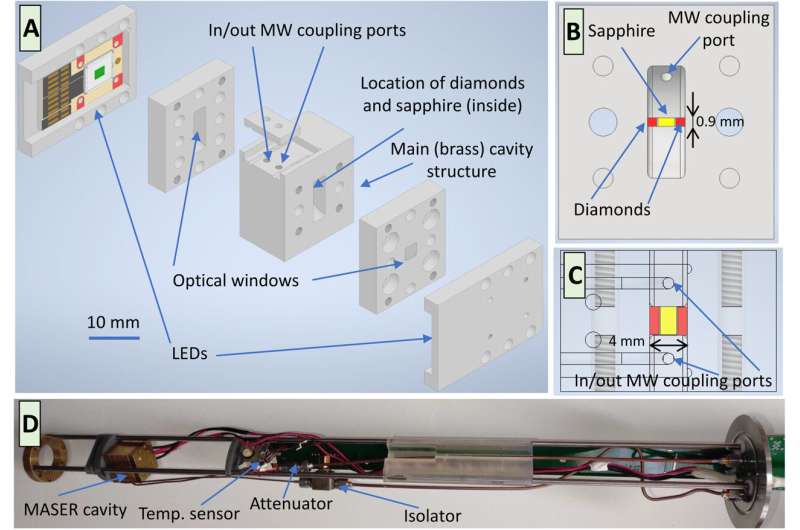
Outlook
In this way, Alexander Sherman and colleagues showed the functionality of a solid-state maser amplifier with quantum limited internal noise at temperatures above liquid nitrogen. The device is useful for modern applications. The team assessed its function in comparison to current technologies on cryogenic, low-noise microwave amplification. The outcomes showed how the diamond maser device enabled quantum-limited amplification performance. The experimental system further disclosed a wealth of nonlinear effects, including multiple echoes and super-radiance; features of significance mainly for research in cavity quantum electrodynamics.
More information: Alexander Sherman et al, Diamond-based microwave quantum amplifier, Science Advances (2022). DOI: 10.1126/sciadv.ade6527
Jonathan D. Breeze et al, Continuous-wave room-temperature diamond maser, Nature (2018). DOI: 10.1038/nature25970
Journal information: Science Advances , Nature
© 2022 Science X Network





















